How to write an abstract is something that can feel tricky at first, but once you understand the basics, it’s actually pretty straightforward. Think of an abstract as a tiny version of your research paper – it’s a single paragraph that tells people what you did, why you did it, what you found, and why it matters. The goal is to give readers a quick snapshot of your work so they can decide if they want to read the whole paper. Usually, it’s only about 150 to 250 words, so every sentence counts, and it needs to flow logically from purpose to methods, results, and conclusion.
These days, you don’t have to do it all from scratch either. There are plenty of AI tools, like Grammarly, Scholarcy, and Originality.ai, that can help you turn your notes into a clear, polished abstract in no time. Some of these platforms even guide you step by step, making sure you hit all the important points and keep your abstract structured properly. Whether you’re a student trying to summarise a project quickly or a researcher preparing a submission for a journal, combining these tools with a simple, clear approach to writing can make the process much less intimidating and a lot more efficient.
5 Easy Steps on How to Write an Abstract
Step 1: Understand what an abstract is
Think of the abstract as a tiny version of your research paper. It tells someone what you did, why, and what you found, all in one paragraph.
- Purpose: Quickly informs the reader about your work.
- Length: Usually 150–250 words.
Step 2: Know the structure
Your abstract should cover four things, in this order:
- Why you did the research (Purpose/Background)
- How you did it (Methods/Approach)
- What you found (Results/Findings)
- Why it matters (Conclusion/Implications)
Step 3: Collect the key points from your research
Before writing, make a small list for each section:
- Purpose – One or two sentences about why the research is important.
- Methods – One or two sentences summarising how you did the research.
- Results – One or two sentences with your main findings.
- Conclusion – One or two sentences about what your results mean or why they matter.
Example of notes:
- Purpose: “I am studying the effect of sleep on memory in teenagers.”
- Methods: “Surveyed 50 teenagers, conducted memory tests after 6 hours vs 8 hours of sleep.”
- Results: “Those who slept 8 hours performed 20% better on memory tests.”
- Conclusion: “Adequate sleep is important for teenagers’ learning and memory.”
Step 4: Write the abstract
Now, combine your notes into a single paragraph. Make sure it flows logically:
Template:
“This study investigates [purpose]. To do this, [methods]. The results show that [main findings]. These findings suggest [conclusion/implications].”
Using the example above:
“This study investigates the effect of sleep on memory in teenagers. Fifty teenagers were surveyed, and memory tests were conducted after six and eight hours of sleep. The results show that those who slept eight hours performed 20% better on memory tests. These findings suggest that adequate sleep is important for teenagers’ learning and memory.”
Step 5: Edit and refine
- Make sure the paragraph is clear and concise.
- Remove extra details – the abstract is only for highlights.
- Check word count: stay within your target limit.
- Read it aloud – does it make sense to someone who hasn’t read your paper?
Blank Abstract Template
This study investigates [what your research is about / the problem you are addressing]. To do this, [briefly describe your method or approach: e.g., experiments, survey, data collection, analysis]. The results show that [main findings – the most important result(s)]. These findings suggest [what the results mean or why they are important / implications].
Step-by-step guide for filling it in
- Purpose / Background – Replace the first bracketed part with one or two sentences about why you did your study.
- Example: “the effect of daily exercise on concentration in university students”
- Methods / Approach – Replace the second bracketed part with a short description of what you actually did.
- Example: “fifty students completed concentration tests before and after a two-week exercise programme”
- Results / Findings – Replace the third bracketed part with the most important outcome.
- Example: “students who exercised daily scored 15% higher on the concentration tests”
- Conclusion / Implications – Replace the fourth bracketed part with what your results mean.
- Example: “daily exercise can significantly improve concentration in university students”
Filled Example
This study investigates the effect of daily exercise on concentration in university students. To do this, fifty students completed concentration tests before and after a two-week exercise programme. The results show that students who exercised daily scored 15% higher on the concentration tests. These findings suggest that daily exercise can significantly improve concentration in university students.
How to Write an Abstract Using AI
Several online tools and platforms can assist in generating abstracts for research papers. These tools employ artificial intelligence (AI) to summarise your content into concise, structured abstracts, saving you time and effort. Here are some notable options:
Grammarly AI Abstract Generator
Overview: Grammarly is widely known for its grammar and writing assistance, and its AI Abstract Generator extends this functionality to academic and professional summarisation.
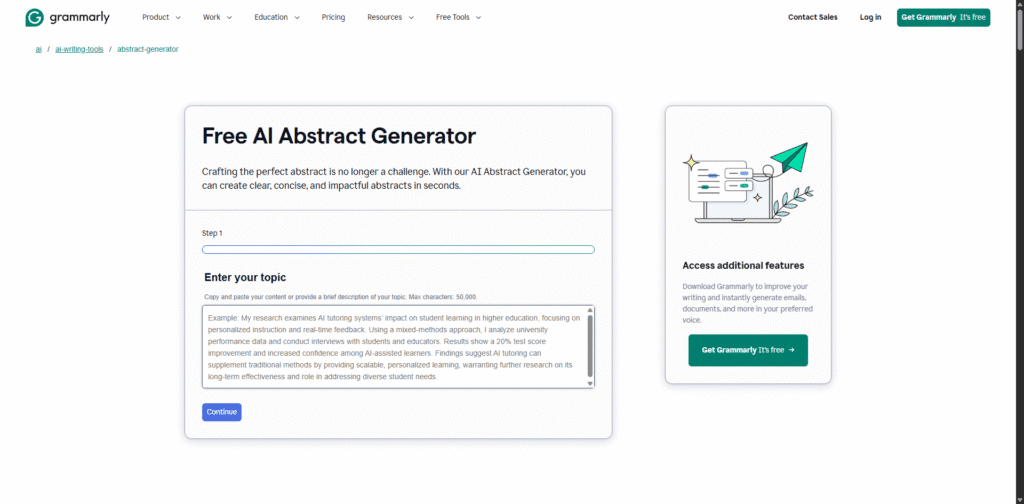
Features:
- Generates well-structured abstracts instantly.
- Supports research papers, essays, reports, and presentations.
- Provides clear prompts and guidance for improved output quality.
Strengths:
- Extremely user-friendly interface.
- Integrated into Grammarly’s ecosystem, making editing and refining abstracts seamless.
- Free to use, with reliable AI-based language suggestions.
Limitations:
- May require manual adjustment for very technical or domain-specific papers.
- The free version may have length or complexity constraints compared with premium tools.
Ideal For: Students, researchers, and professionals who already use Grammarly and need a fast, polished abstract.
Originality.ai Abstract Generator
Overview: Originality.ai focuses on producing structured, academically rigorous abstracts by analysing key themes and findings.
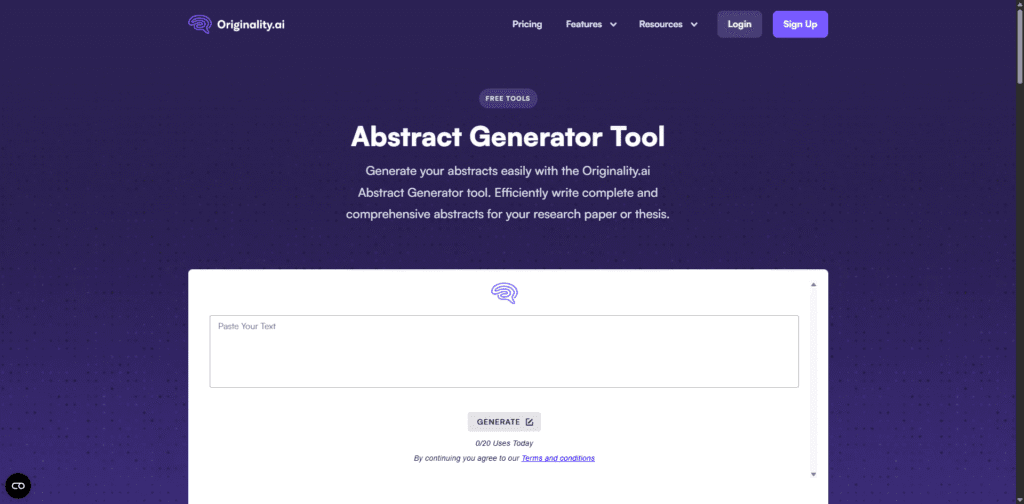
Features:
- Identifies key results and summarises conclusions.
- Produces professional, formal abstracts suitable for journals.
- Supports structured academic writing.
Strengths:
- High accuracy in capturing core findings.
- Generates academically credible summaries that can be used in formal submissions.
- Ideal for research-heavy papers.
Limitations:
- May have a steeper learning curve compared with simpler tools.
- The AI may occasionally prioritise generalisation over nuanced details in highly technical research.
Ideal For: Researchers, academics, and authors aiming for formal, publication-ready abstracts.
Paperguide AI Abstract Generator
Overview: Paperguide is designed to quickly produce concise and impactful abstracts, supporting multiple output formats.
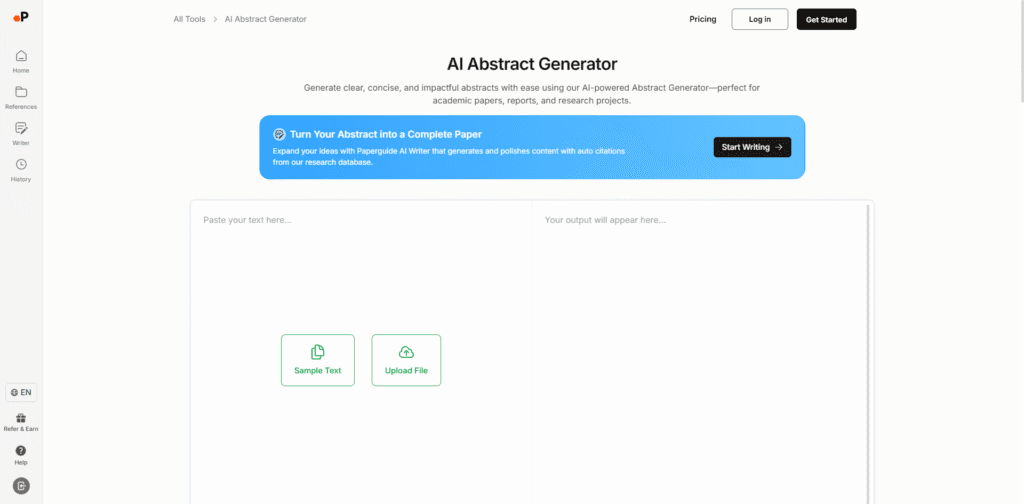
Features:
- Generates abstracts for academic papers, reports, and projects.
- Supports PDF, DOCX, and TXT formats.
- Emphasises clarity and conciseness.
Strengths:
- Flexible output options make it easy to integrate abstracts into different platforms.
- Produces professional, readable summaries quickly.
- Minimal effort required; suitable for tight deadlines.
Limitations:
- May not handle very complex or lengthy research documents as well as some competitors.
- Limited advanced AI editing features beyond abstract generation.
Ideal For: Students and professionals needing quick, versatile abstracts in multiple formats.
Summarizer.org Abstract Generator
Overview: This tool leverages advanced AI and machine learning to deeply analyse content, producing high-quality and unique abstracts.
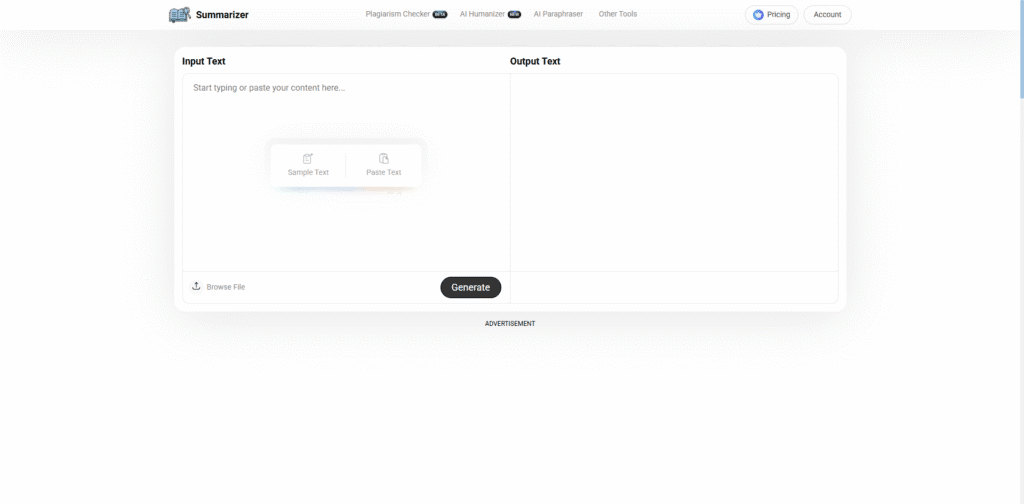
Features:
- Uses machine learning to understand content and context.
- Free and secure to use.
- Capable of producing unique abstracts that avoid generic phrasing.
Strengths:
- High-quality and unique abstract generation.
- Deep understanding of the source content improves accuracy.
- Completely free, making it accessible to all users.
Limitations:
- Interface may be less intuitive compared with more polished commercial tools.
- Might require additional formatting for publication standards.
Ideal For: Researchers and students who need a free, reliable, and AI-driven summarisation tool with a focus on quality.
Coral AI Abstract Generator
Overview: Coral AI specialises in quickly summarising long documents, providing not only abstracts but also page references for easier review.
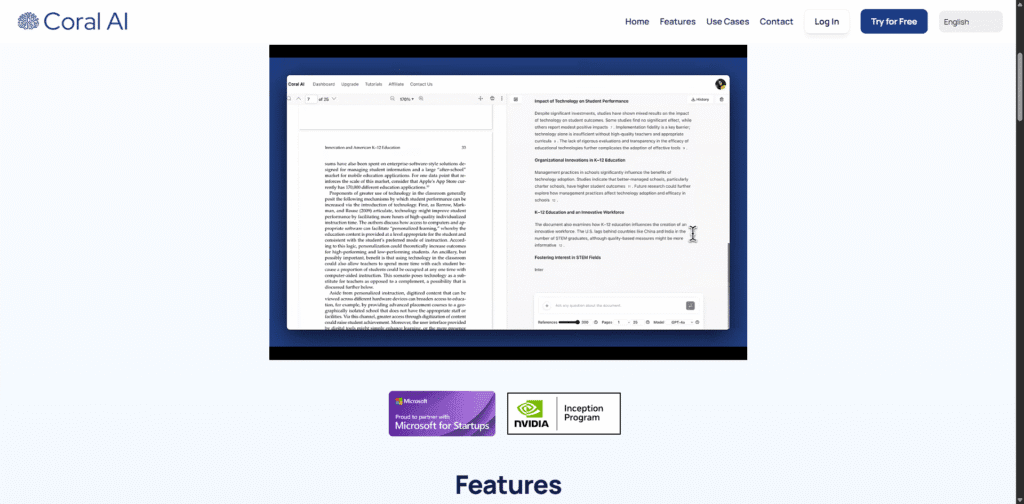
Features:
- Summarises long documents in seconds.
- Provides page number references for key points.
- Designed to save significant time in research and review processes.
Strengths:
- Excellent for lengthy research papers or multi-page reports.
- Speed and efficiency are its key advantages.
- Useful for literature reviews, thesis writing, and report preparation.
Limitations:
- May occasionally over-condense complex arguments.
- Free version may have restrictions on document length or features.
Ideal For: Academics and researchers working with extensive documents who want rapid, reference-linked summaries.
How to Write an Abstract Using Structured Abstract Template Generators
Structured abstract template generators guide users through the process of writing clear and well-organised abstracts. By following predefined sections like objectives, methodology, and findings, these tools simplify abstract creation while ensuring academic standards are met.
Classgist Abstract Generator
Overview: Classgist provides a structured approach to writing abstracts by guiding users through each essential section of a research abstract.
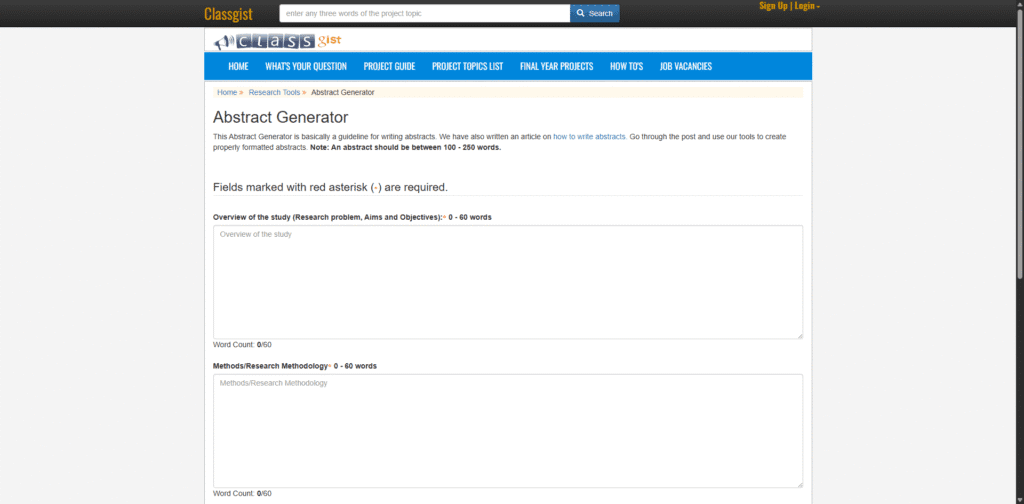
Features:
- Offers step-by-step guidelines for writing abstracts.
- Breaks down abstracts into key components: research problem, aims, objectives, methodology, and findings.
- Ensures properly formatted abstracts suitable for academic standards.
Strengths:
- Excellent for beginners or students learning how to write structured abstracts.
- Helps maintain clarity and organisation, ensuring all critical sections are included.
- Encourages academic best practices in abstract composition.
Limitations:
- Less automated than AI-based generators; users still need to input and refine content manually.
- Not ideal for very fast abstract creation since it relies on user interaction.
Ideal For: Students, early-career researchers, or anyone who wants to ensure their abstract is methodical, properly structured, and academically rigorous.
Editpad Abstract Generator
Overview: Editpad simplifies abstract creation by automatically combining key phrases from a document into a concise abstract.
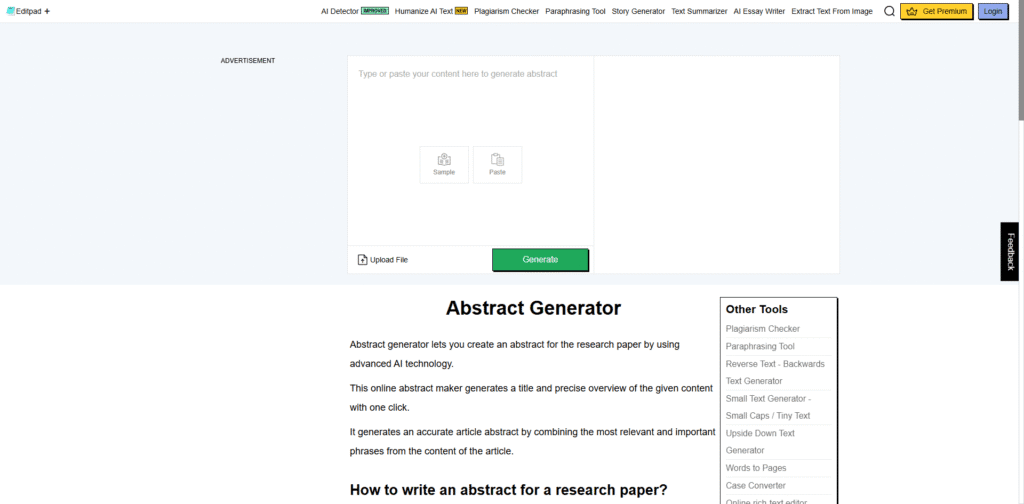
Features:
- Generates an article abstract with a suitable title in one click.
- Extracts the most relevant and important phrases from the content.
- Quick, automated process for summarising research or articles.
Strengths:
- Extremely fast and convenient; minimal user input required.
- Produces abstracts that are clear and relevant to the source content.
- Ideal for preliminary drafts or summarising content quickly.
Limitations:
- Less focus on structured formatting; may not clearly separate sections like methodology, results, or objectives.
- Works best with concise or moderately complex documents; very technical papers may require further editing.
Ideal For: Writers or researchers who need a quick abstract for articles, reports, or notes, particularly when a structured format is less critical.
How to Write an Abstract Using Paper Summarisation Tools
Scholarcy
Overview:
Scholarcy is an AI-powered article summariser designed to extract key information from research papers, journal articles, and reports. It identifies important points and generates concise summaries, helping users quickly grasp the core arguments and discussions.
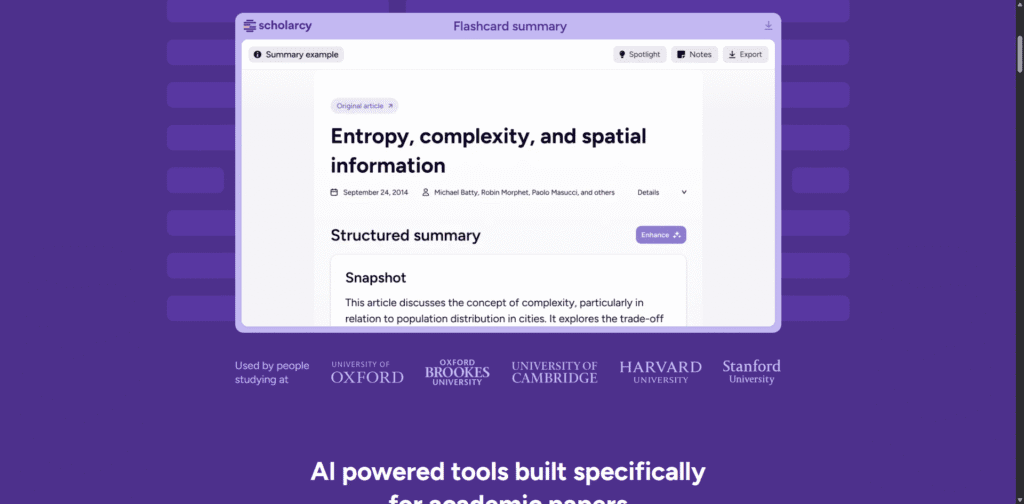
Key Features:
- Flashcard Summaries: Scholarcy converts documents into interactive flashcards, highlighting key concepts, claims, and findings. This format allows users to quickly understand the essence of a paper without reading it in its entirety.
- Reference Integration: The tool can integrate with reference managers, streamlining the process of managing citations and bibliographies.
- Multi-Document Support: Scholarcy supports summarising multiple documents simultaneously, making it efficient for literature reviews and comparative analyses.
- Browser Extensions: Available as browser extensions for Chrome, Edge, and Firefox, allowing users to summarise documents directly from their browsers.
Strengths:
- Efficiency: Significantly reduces the time required to comprehend lengthy academic texts.
- Structured Output: The flashcard format provides a clear and organised summary of the document.
- Integration Capabilities: Seamless integration with reference managers enhances the research workflow.
Limitations:
- Premium Features: Some advanced features are behind a paywall, which may limit access for users on a budget.
- Mobile Accessibility: Lacks dedicated mobile applications, which may hinder users who prefer mobile access.
- Multimedia Limitations: Does not support summarisation of multimedia content such as videos or audio files.
Ideal For:
Researchers, students, and academics seeking an efficient tool to summarise and understand complex scholarly documents.
AskYourPDF
Overview:
AskYourPDF is an AI-powered tool that allows users to upload PDF documents and interact with them through natural language queries. It provides concise summaries and enables users to ask specific questions about the content.
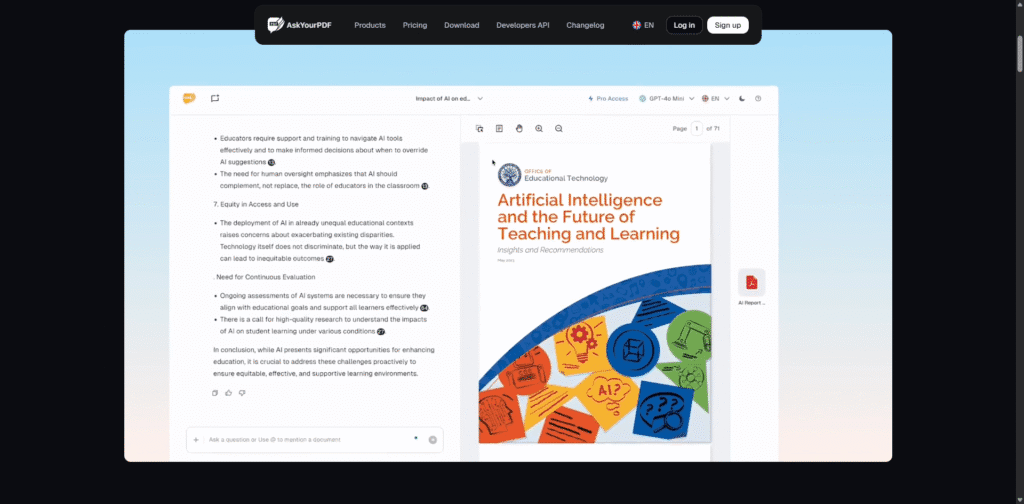
Key Features:
- Document Upload: Users can upload PDF documents directly to the platform for analysis.
- Natural Language Interaction: Allows users to ask questions about the document’s content in plain language.
- Summary Generation: Provides concise summaries of the uploaded documents, highlighting key points.
- Interactive Q&A: Enables users to engage in a Q&A format, facilitating a deeper understanding of the document’s content.
Strengths:
- User-Friendly Interface: The platform is intuitive and easy to navigate, making it accessible for users with varying technical skills.
- Time-Saving: Quickly processes and summarises large documents, saving users significant time.
- Interactive Features: The Q&A functionality allows for a more engaging and thorough exploration of the document’s content.
Limitations:
- Customer Support: Users have reported issues with customer service responsiveness, which may be a concern for those requiring assistance.
- Pricing Structure: Some users find the pricing plans to be expensive, particularly for casual users.
- Privacy Concerns: There are limited details available regarding the platform’s privacy and data handling practices.
Ideal For:
Individuals seeking an interactive and efficient way to summarise and understand PDF documents, especially those who prefer a conversational approach.
Conclusion
In conclusion, writing an effective abstract doesn’t have to be overwhelming. By focusing on the key elements – purpose, methods, results, and significance – you can create a concise snapshot of your research that communicates its value clearly. Whether you choose to write it manually or use AI tools to streamline the process, the most important thing is clarity and accuracy. A well-crafted abstract not only helps readers understand your work quickly but also sets the stage for the impact your research can have.
To dive even deeper and discover practical tips on accessing full research papers without cost, check out our blog post on Download Research Paper Free – it’s packed with resources that can save you time and effort in your research journey.

